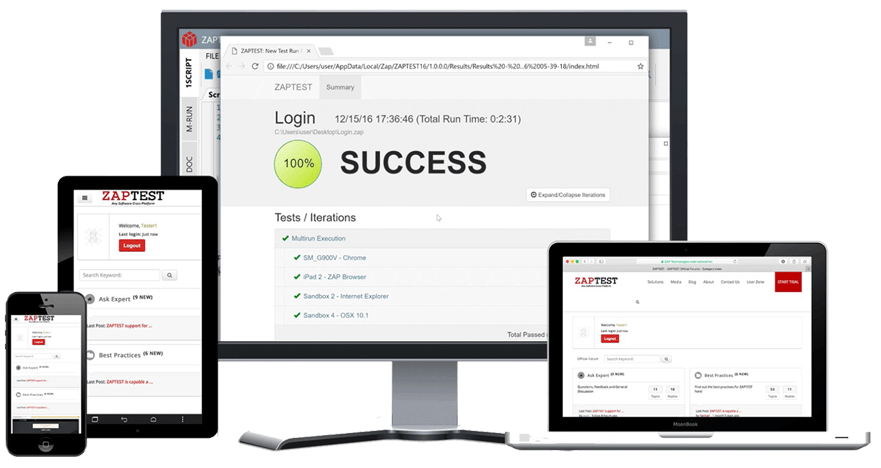Negative testing in software testing is a technique that verifies how your application reacts to unexpected behaviors or invalid data. This type of testing can help Quality Assurance teams improve the robustness and stability of their software by hunting down exceptions that cause freezes, crashes, or other unwanted outcomes.
In this article, we’ll explore what negative software testing is, why it’s important, and some of the different approaches, techniques, and tools that you can use for this technique.
What is negative software testing?

Negative testing is a software testing technique that intentionally feeds a system with invalid inputs or unexpected data to see how it handles these scenarios. Also known as failure testing or error path testing, this approach simulates the diverse range of real-world scenarios your application will encounter, such as users entering invalid dates or characters or using certain functionalities in ways that you never intended.
Most types of testing use valid data to test an application. However, negative testing takes a different approach by testing around the edges and beyond typical inputs and seeing how the application handles exceptions.
Testing that your application performs as intended is important. But, on the flip side, understanding what happens when users go off the reservation is vital, too, particularly if these unintended uses cause crashes, freezes, or other defects.
Difference between positive testing and negative
testing in software testing
As we outlined above, negative testing uses unexpected or invalid data to verify the behavior of a system. In contrast, positive testing pushes expected or valid data to verify that the system works as expected.
In other words:
- Positive testing helps you understand if your application works as planned
- Negative testing determines if your application can handle unexpected events
Both positive testing and negative testing in software testing are required if you want to test your application rigorously.
Why is negative software testing vital?
When developers build software, they have a clear idea of how they expect the user to use the software. However, users don’t always follow the rules. Quite often, they’ll try to click on buttons that don’t exist, enter letters into number fields, or try inputs that you just don’t expect.
Negative testing aims to account for these edge cases that can’t be uncovered by positive testing techniques like unit, system, or integration testing. It requires some unconventional thinking to come up with “curve balls” to throw at the system. However, the net result is a more stable and robust application.
What is the purpose of negative testing
in software testing?
Negative testing has similar goals to those of other types of software testing. Namely, to uncover bugs, defects, and vulnerabilities in an application. However, it plays a special role in finding defects that cannot be uncovered through the use of valid data. Here are some of the reasons to adopt a negative testing approach.
1. Exposing defects
The central purpose of negative testing in software testing is to uncover defects that result from invalid data or unexpected inputs. It allows testers to take a more proactive approach to bug detection and ensure that the software is up to expectations.
2. Security
Unexpected inputs or invalid data can expose security vulnerabilities. Testing and resolving these edge cases leads to a more secure and robust application by reducing the possibility of malicious attacks, injection flaws, or unauthorized access attempts.
3. Error handling
Negative testing is useful for validating error handling. It’s not just about ensuring that the system stays stable after encountering unexpected inputs or data but also about how it responds to these events, such as producing error messages to ensure the end user knows the data is invalid.
4. Improving test coverage
Positive and negative testing in software testing are hugely complementary. They both cover different elements of data input, which means your testing is more comprehensive.
5. Better user experience
Negative testing helps discover the source of error messages, crashes, and other unexpected behaviors that can negatively impact user experience.
Difference between positive and negative
testing in software engineering
As we mentioned above, negative testing sends unexpected or invalid data to verify the behavior of a system. Positive testing, on the other hand, sends expected or valid data to verify that the system works as expected.
The difference between positive and negative testing include:
1. Objectives:
Positive testing verifies if the software works as intended; negative testing seeks to understand what happens in unintended scenarios.
2. Data:
Positive testing uses valid data, and negative testing uses invalid inputs, extreme values, and unexpected formats.
3. Focus:
Positive testing focuses on success scenarios, while negative testing is more concerned with unsuccessful scenarios.
Different types of negative testing
Negative testing is a concept that covers several different approaches to validating the quality and integrity of an application. Here are seven types of negative testing you need to know.
#1. Boundary value testing
Boundary value testing seeks to test the software with inputs that are at the borders or edges of the input range. It tests both the maximum and minimum expected values but also tests just beyond these inputs.
Example: An input field accepts numbers between 1-9. A boundary value test will input both 1 and 9 but also test 0 and 10.
#2. Input value testing
Input value testing determines how the system will respond to unexpected or invalid inputs. Some of the inputs it will test include:
- Incorrect data types
- Out-of-range values
- Special characters
- Empty fields.
Example: An input box requires a number only, so the test will input a letter and see how the system responds.
#3. Load testing
Load testing helps testers evaluate how the system will respond under heavy stress or loads, such as large data sets or high volumes of traffic. Test automation tools can simulate these extreme conditions to understand how the system reacts under duress.
Example: The tester will simulate thousands of concurrent users accessing a website.
#4. Exception testing
This type of testing explores how the system will respond to exceptional events or errors. Some of the tests include
- Simulating system crashes
- Network failures
- Database errors
- Disk space issues
- Missing files.
Example: The test might explore what happens when a user is downloading a file from the application, and the internet is cut off.
#5. Security testing
Security testing uses a negative testing approach to highlight and understand vulnerabilities in the software that can be exposed by invalid or unexpected inputs. This approach tests for common attacks, such as:
- SQL injection
- Cross-site scripting (XSS)
- Buffer overflows.
Example: A security test might attempt to inject malicious code into a user input field.
#6. User interface testing
This kind of testing focuses on errors that occur when the user interacts with the software. Some of the things it will try to determine include:
- Unexpected responses to user interactions
- Incorrect error messages
- Navigation problems
Example: The test will explore what happens when particular actions are performed out of sequence.
#7. Data Integrity Testing
Data integrity testing ensures that data remains accurate and consistent across a variety of operations within the application. Some of the things under test include:
- Potential data corruptions
- Data loss scenarios
- Inadvertent data modifications
Example: The test will verify that data stays the same after a transmission.
As you can see, there are lots of different negative testing approaches. What they all have in common is the use of unexpected inputs or invalid data to see how the application works under atypical conditions.
Advantages of negative testing
Negative testing is all about understanding how your application works when unexpected situations arise. Here are some of the main benefits of using this approach.
- It helps you understand the impact that unexpected inputs or invalid data will have on your application. Will it crash? Spit out an inaccurate error message?
- Negative testing is part of a responsible Quality Assurance approach because it seeks to identify weaknesses in the system
- Negative testing puts the software through its paces by testing its response to unforeseen or unanticipated scenarios that it will encounter in the wild
- Again, negative testing is an essential component of a thorough approach to security because it highlights potential attack vectors that cyber attackers might take advantage of.
Disadvantages of negative testing
Negative testing offers a wealth of benefits, but it has some downsides that must be overcome, too.
- Thorough negative testing can require additional hardware and software, which can increase the costs of testing. For teams operating on a tight budget, this can be disadvantageous.
- Negative testing can be fairly time-consuming because it requires the creation of many test cases to cover the various permutations of inputs that the software will face in production
- There are limits to the amount of unpredictable situations that you can cover with negative testing. Indeed, some situations might be so unexpected that testers can’t consider them.
- Automation of negative test cases is challenging. However, with the right software, such as ZAPTEST, the process is far more manageable.
Challenges of negative testing
Negative testing is crucial if you want to build robust and reliable software capable of withstanding the stresses and strains of user interaction. However, there are some challenges to implementing the approach that you need to be aware of.
Let’s break down some of the more persistent challenges.
1. Identifying negative scenarios in software testing
Sufficient coverage:
One of the biggest challenges in negative testing is ensuring that you cover enough unexpected scenarios. There are a lot of negative scenarios and permutations, so considering them all requires taking a creative approach to imagining how your users will interact with the software.
Prioritization:
With so many potential negative scenarios to put under the microscope, testers aren’t always sure where they should start. Some solid criteria for evaluating what to prioritize include forecasting:
- Situations with a high likelihood of defects
- The severity of the outcome of defects.
2. Designing adequate negative test cases
Input validation:
Designing solid negative test cases requires a fairly comprehensive understanding of your system’s behavior, architecture, and limitations. Testing the software requires using carefully considered inputs and data. While taking a random approach can help you reveal some defects, it pales in comparison to a more precise and systematic approach to negative testing.
Data diversity:
Depending on the particularities of your system, you might need to test against a fairly diverse set of data. Indeed, there are many different data formats, such as numbers, text, dates, and so on, each of which your application might accept. The challenge here involves designing test cases that can account for each format and, in particular, each variation of invalid data. This situation can be fairly time-consuming for testing teams.
3. Efficiency and Test Automation
Time-consuming:
Positive testing aims to validate the software against expected outcomes. Negative testing, on the other hand, must delve into the unexpected and explore potential scenarios. Going over uncharted territory takes more time. As a result, if you want the comprehensive results that come with negative testing, you must be prepared to invest some extra hours.
Automation complexity:
Negative testing can be time and resource-intensive. As such, it’s a perfect job for software test automation. However, there are some complexities that must be overcome. For example, designing test cases that define expected outcomes for unexpected inputs takes some experience and know-how. Additionally, your existing framework for automation tests might not support the invalid data you want to push to your application, adding a further layer of complexity.
4. Evaluating results
False positives:
Calibrating your testing to ensure a satisfactory balance between accuracy and comprehensiveness is a familiar issue for negative testers. In some situations, oversensitive error handling will falsely confuse valid inputs for negative inputs, leading to time being wasted on problems that are not relevant.
Ambiguous results:
When a system receives an invalid input, it can result in crashes, errors, or freezes. In many cases, this is a sure sign of a bug. However, in others, it is evidence of an unhandled edge case that developers did not consider. Distinguishing between these discrete situations is important, but investigating the true cause is time-consuming.
Data management:
Negative testing requires a considerable amount of data. This testing information must be both generated and maintained. In development scenarios with tight timeframes, this is an extra job that must be considered.
5. Organizational issues
Lack of negative testing expertise:
While negative testing is popular, many testers lack the skills and expertise to implement this kind of testing in a comprehensive manner. Designing certain negative test cases is less intuitive than their positive test case equivalent. What’s more, implementing test automation can also be challenging without the right expertise.
Business pressure:
Stakeholders, testors, and management must understand the critical role that negative testing plays in the development of robust applications. Failure to appreciate its importance can lead to pressure to focus on positive testing at the cost of negative testing.
It’s clear that there are several challenges facing teams who want to unlock the benefits of negative testing. However, with the right approach and the right software testing tools, you can overcome these issues and build software that goes above and beyond users’ expectations.
How to write software testing negative test cases
Writing software testing negative test cases requires some experience and creative thinking. Here is a step-by-step guide to help you build these critical test cases.
#1. Establish your objectives
Before you write your software testing negative test cases, you need to understand why you want to perform negative testing. Not all applications benefit from negative testing.
So, understand what you want to achieve. Negative testing is designed to unearth errors and crashes that result from unexpected user interaction scenarios or conditions.
#2. Outline potential negative scenarios
Next up, you need to make an account of the sort of negative scenarios that may occur when users interact with your software. Research during this step is crucial. Some areas that you should explore are:
- System requirements
- Typical use cases
- Application features and functions
Mine these situations and make a list of scenarios where the application might not function as you have intended.
Then, consider critical input validation scenarios. Typically, this will involve data entry forms, login fields, and so on.
Finally, consider the myriad of unconventional ways that users might interact with your software and unexpected events that can produce adverse outcomes, like network disconnections, abrupt system shutdowns, massive data transfers, etc.
Once you have documented as many scenarios as possible, it’s time to determine the expected outcomes of these unexpected scenarios.
#3. Outline expected outcomes
Each test case must have an expected outcome, and a negative test case is no different. The best practice here is to write out each negative scenario and determine what the outcome should be.
Some of the potential outcomes may include:
- Accurate and informative error messages
- Appropriate redirections
- Graceful system handling, for example, preventing system freezes or crashes.
#4. Select inputs to test
Now, it’s time to see which inputs you need to test. These inputs should be the ones that are most likely to cause an error or other negative behaviors.
Some inputs you need to include are:
- Out-of-range values (negative values in an age field, etc.)
- Invalid data (letters in a numeric field, etc.)
- Unexpected characters or symbols
- Special characters
- Missing data
#5. Write your test cases
Once you’ve gathered all your scenarios, it’s time to write your test cases. Now, with negative testing, there is an almost unlimited number of test cases that you could write. After all, this type of testing is about finding what happens when people use the software in ways that you didn’t intend. However, deadlines dictate that you cut the list of potential cases down into situations that are most likely to cause issues.
As always, write your test cases in clear, concise, and objective language. There is no room for ambiguity here.
Here is a good format for your negative test cases.
- Use a Test Case ID
- Describe precisely what is being tested
- Note any preconditions for your negative test
- Outline the set of steps involved
- Establish clear and objective outcomes
- Note down the actual outcome of your test
#6. Schedule the test
Now, you need to schedule your tests. Again, it’s important to prioritize the scenarios that have the most severe adverse outcomes, such as crashes, or where issues are most likely to be uncovered.
Example negative test case
Here is an example of a negative test case.
Test Case ID: TC001
Description: Verify that an error message shows if the user enters an invalid email address
Preconditions: The user must be on the application login page
Steps: 1. Enter an invalid email address. 2. Press “Login”
Expected outcome: When the user hits “Login,” an error message occurs, saying “incorrect email address entered.”
Outcome: Record what happened when “Login” was selected.
Examples of negative scenarios in software testing
Here are some typical scenarios that you can verify by using negative testing methods.
1. Data and field types
If you’ve filled out a form online, you’ll know that these boxes are set to accept particular types of data. Some are numbers only, while others accept dates, text, or other types of data.
Negative testing for these boxes involves sending invalid data, for example, entering letters into a numeric field.
2. Required fields
Again, required fields are common features of forms and applications. They are a handy tool for ensuring all critical information is gathered before the user proceeds to the next stage.
A good test case for these scenarios involves seeing what happens when these fields are left blank. In an ideal scenario, an error message should be triggered, urging the user to fill in the required field.
3. Appropriate number of characters
If you have an application of web pages under test, you might have a data field that requires a limited number of characters. This could be for user names, phone numbers, registration numbers, and so on.
You can create negative test cases for these fields by writing tests that input over the maximum allowable characters to see how the app responds.
4. Data bounds and limits
Certain forms will have fields with fixed limits. For example, if you wanted someone to rate something out of 100, the data bounds would be 1-100.
Create a negative test case where you attempt to enter 0, 101, or other negative or positive values out of 1-100.
Best Practices for Negative Testing
There are several best practices involved in ensuring high-quality negative testing. Here are some tips to help you get there.
1. Define your invalid inputs:
Pour over development documentation, use cases, and UI/UX to understand and identify potential invalid inputs. Look out for invalid data types, extreme values, missing data, empty fields, unexpected formats, and more.
2. Use boundary value analysis:
As mentioned above, outline your boundary values to find edge cases that may cause unexpected reactions.
3. Employee equivalence partitioning:
Look at your input domains and split them into equivalence partitions of both valid and invalid values. This process helps reduce the number of test cases you’ll need to write because if an equivalent piece of invalid data causes issues for one input, it will likely be represented across the entire class.
4. Mimic bad users:
Positive testing verifies expected user behavior. Negative testing explores what happens when people misuse your app. So, think about the different scenarios where this can happen and replicate them in your test cases.
5. Let risk and impact guide your testing:
No tester has unlimited time. At some point, you’ll need to make difficult choices because you can’t test for (or even know) every unexpected outcome. When you need to decide which types of negative tests to run, prioritize the areas that will bring the most risk or negative impact to your product.
6. Error handling verification:
Ensure that you make error handling a part of your testing, verifying that error messages are useful and accurate.
7. Automate as much as possible:
Automation is adept at handling mundane and repetitive tasks. However, negative testing still requires a manual approach for exploratory testing and finding edge cases.
The best negative testing tools for 2024
While negative software testing is common across the industry, there is a lack of distinct tools for the job. A big reason for this is the versatile nature of negative testing. What’s more, many of the same tools that are used for positive testing work for negative testing when you adjust the input data.
ZAPTEST is the best tool for negative testing because of its versatile and modular nature. It’s easy to use and customizable, and thanks to cross-platform and cross-application capabilities, it offers a flexibility that is hard to beat.
Data-driven testing and mutation testing functionality make ZAPTEST perfect for negative testing. What’s more, thanks to its RPA features, you can simulate real-world users, reuse tests, and build reports and documentation with ease. In a nutshell, ZAPTEST’s ability to run state of art software automation and Robotic process automation software makes it a one-stop shop for any automation task, including negative testing.
Final thoughts
Negative testing in software testing helps teams understand how their application will handle unexpected inputs and invalid data. While positive testing tests to see if your software functions as intended, negative software testing helps you figure out what happens when users select inputs and data incorrectly. Both approaches are important if you want a solid and robust application that can handle the stresses and strains of diverse user interaction.















